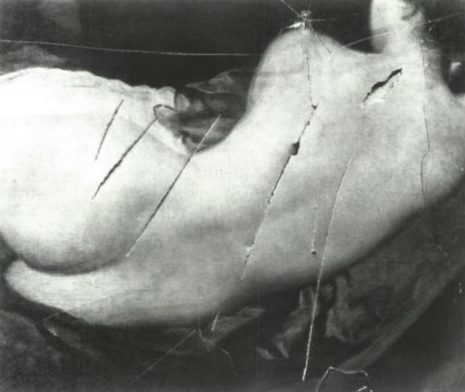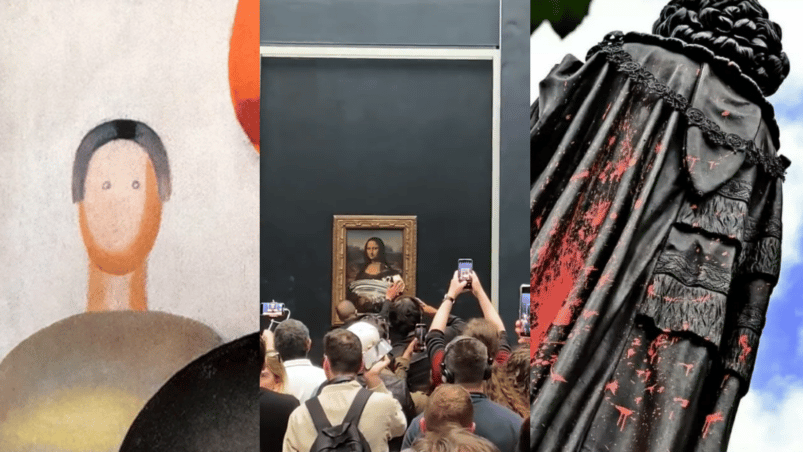The Mona Lisa is again the target of cultural vandalism this week. Cultural heritage and art objects are often the target for vandals wanting to send a message to the world. Fortunately, protective measures and teams of expert restorers are often able to prevent damage.
Showing cultural heritage to the public is always a risk. Valuable artefacts are an obvious target for people wanting to ‘send a message’, and museums should be aware of the surprising history of art vandalism.
Cake on the Mona Lisa

The stunt may have inspired some of the best headlines this year: someone dressed as an old woman in a wheelchair threw cake at the world’s most famous Italian rennaissance painting. The vandal was quickly taken away by security, and the glass shield protected the painting from any culinary damage.
However, this is far from the first time that Leonardo da Vinci’s masterpiece has been threatened: in 1911 an Italian patriot working at the Louvre hid in a broom cupboard at the museum. After the gallery closed, he concealed the work under his coat and took it back to his appartment. His attempt to repatriate the painting to Italy was unsuccessful, but the theft brought the painting into the public spotlight.
In the 1950s, there were two attacks. One vandal had attempted to cut the painting with a knife, which led the Louvre to put up a panel of glass to protect it. Months later, another vandal threw a rock at the painting. The rock bounced off the protective screen, but a fragment of glass landed on the painting and damaged some pigment. Since then, the painting is only displayed behind bullet-proof glass.
In 1974, a woman tried to spray-paint a message onto the canvas while it was on display at the Tokyo National Museum. In 2009, someone threw a ceramic cup at the painting. The protective glass screen protected it from damage in both cases.
Cartoon eyes on Russian modernism
Security guards are often the ones called to stop vandalism – but in this case a museum guard was the perpetrator. “Three Figures” by Anna Leporskaya is a valuable piece of Russian avant-garde artwork painted in the 1930s, notably lacking any facial features until a member of staff from a security firm drew on eyes in 2021.

Why the guard decided to draw eyes on with a ballpoint pen is not clear, and many headlines suggested that he was ‘bored’. Later, however, he claimed to have been goaded by teenagers to give the artwork facial features, in an interview reported by Artnews. Fortunately, the damage to the painting was minimal and did not cost too much to repair.
Given the press coverage that the artwork received, perhaps the security guard should have been given a pay rise instead of being fired?
Margaret Thatcher statue egged within a day
Whoever signed off on the new statue of the former British Prime Minister must be a brave person. While some see Thatcher as a strong leader who brought Britain forward, many blame her for causing widespread deprivation and poverty. A statue of such a divisive figure was inevitably going to attract attention.
It had only been unveiled for a few hours in Thatcher’s home town of Grantham before a disgruntled member of the public threw eggs on it. Whilst the statue was quickly protected with barriers, this did not stop further vandalism from happening two weeks later when it was doused in red paint.
It seems likely that fans and critics of the Iron Lady will pay visit to the site for years to come, with many still wanting to share their feelings about her legacy.
Selfie leads to broken toes
Not all vandalism is intentional – some is merely stupid. One visitor to the Museo Antonio Canova was a little too enthusiastic about taking a selfie with a statue of Pauline Bonaparte as Venus Victrix (1804). The visitor was attempting to sit on the piece while taking a photo when he broke the toes off. When the museum reviewed security footage, they discovered that the culprit had fled without telling anyone of the damage. The later tweeted that the tourist identified handed himself in to the authorities.
Fortunately restoration was an easy fix, but the accident is an important reminder – heritage is often more fragile than we realise. Oh, and don’t touch museum exhibits.
Slashing the Rokeby Venus for Feminism

This 17th century nude is well-renowned. Art critics have described it as a “paradigm of female beauty”. To suffragette Mary Richardson, however, it was a target.
She entered the National Gallery on the 10th March with a meat cleaver, and was able to get seven slashes down the painting.
She was protesting against the arrest of notable suffragette Emmeline Pankhurst in the days prior. Despite the scale of the damage, the painting was carefully repaired by the gallery’s chief restorer.
The attack certainly sent a message: the press dubbed her “Slasher Mary”.
Sources: The Art Newspaper, Artnet, Pinknews, BBC, Wikipedia.

